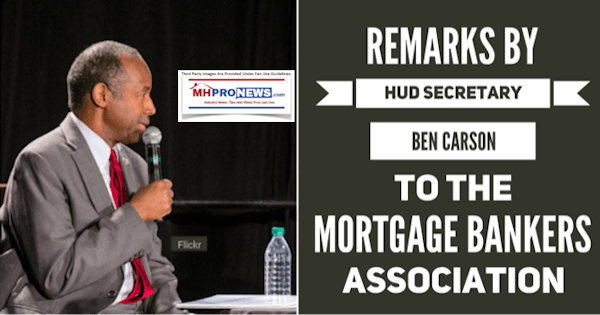
Flashing back to 2016, among the former GOP contenders to announce their support for Donald J. Trump to become the 45th president was Ben Carson, M.D.
Flash-forward to the present. Now HUD Secretary Carson has been an earnest and dependable supporter of President Trump and his agenda. While he has floated the notion that he may step aside at HUD after the 2020 race, there has never been any serious flap at HUD about the security of his tenure there.
Carson has stated his support for manufactured housing numerous times. Part of that, on a practical level, must include financing options. That is one of several topics addressed in his comments, below.
It is useful to see what Carson says to audiences other than manufactured home professionals. Links to other reports that deal with Carson’s comments to senators or others are further below. But let’s see what his prepared comments were yesterday to the powerful Mortgage Bankers Association (MBA), in Washington yesterday.
Remarks by Secretary Ben Carson
Mortgage Bankers Association National Advocacy Conference
Washington, D.C., Capital Hilton, April 2, 2019
As prepared for delivery. The speaker may add or subtract comments during his presentation. Provided by HUD to MHProNews.
Thank you, Bob, for those kind words. And thank you to the talented MBA staff for organizing this important conference, as well as to the many leaders, professionals, and pioneers in our industry here today.
To the more than 325 million men and women who call our country home, housing is not just a pillar of our nation’s economy – it is the foundation on which families, and their futures, are often built.
There are signs that this future looks as bright – or perhaps brighter – than ever before. Under President Trump’s leadership, America has witnessed historic highs in employment, job creation, and economic growth.
A recent Gallup poll reported that 69 percent of Americans expect to be better off this time next year than they are today. This financial optimism is not only a 16-year high, it’s within two percentage points of an all-time record.
But every doctor knows that a patient can look like a paragon of health, while latent and localized conditions go untreated underneath. If any part of the body is allowed to languish, every part of the body will eventually feel its pain. Our vital organs are all in it together.
So too it is with America. We are only the Land of Opportunity when opportunity is available to all. And HUD is tasked with a special mission to carry our nation’s new gains to the local doorsteps of vulnerable communities who need help most.
At HUD, our aim is to ensure every American has access to decent, safe, and affordable housing. Both HUD and the MBA share a common understanding: that improving access to capital is a critical driver of economic opportunity.
Today, I’d like to share some of HUD’s initiatives to increase access to financing across the housing industry, the many successes we’ve already begun to see, and how we are embracing responsible reform in the months ahead.
Opportunity Zones
One program expected to greatly increase access to capital while expanding affordable housing is the Opportunity Zones initiative.
Created by the 2017 Tax Cuts and Jobs Act, Opportunity Zones are designed to stimulate economic development and job creation by incentivizing long-term capital investments in low-income neighborhoods. These Zones are structured to serve local communities for the long-term. Only investors who commit capital for five, seven, and ten years receive rewards. That means new growth becomes consistent growth and new jobs become steady jobs.
When new businesses are “here today, gone tomorrow,” residents face an uncertain future. But when they know new businesses are “here today, here to stay,” residents can plan for the long-term future of their neighborhoods, including by applying for mortgage loans and becoming homeowners.
And Opportunity Zones are not a small, incremental initiative – they represent massive action to encourage financial capital to be invested in distressed communities.
For perspective, the National Council of State Housing Agencies announced last month that its Opportunity Zone Fund Directory had expanded to nearly $24 billion dollars in anticipated investments. Of those $24 billion dollars, 91 percent of the funds are planning to invest in multifamily residential, student housing, mixed-use, hospitality, or other commercial development.
We have already heard positive reports from city officials that anticipated investments in Opportunity Zones have helped preserve and attract economic development into their localities. And these are still just the early days. The Department of Treasury estimates Opportunity Zones will attract more than $100 billion dollars in private investment.
To ensure Opportunity Zones reach their potential, President Trump established the White House Opportunity and Revitalization Council, which I have the privilege to chair. The Revitalization Council consists of members across 13 agencies and will prioritize Opportunity Zones in a variety of federal efforts, including deregulation, grant funding, loan guarantees, infrastructure spending, and crime prevention.
By utilizing a single body to achieve interagency consensus – rather than having 13 separate departmental processes – the Revitalization Council can achieve faster resolution, and that means we can deliver much faster solutions.
LITHC Expansion
HUD is also adding positive incentives for the construction and sale of affordable homes by expanding HUD’s Low-Income Housing Tax Credit Pilot for multifamily home development.
This expanded initiative will streamline the processing of FHA insurance applications for projects with equity from the LIHTC program. It’s part of our commitment to further align our policies and underwriting towards supporting affordable housing production and preservation.
Because New Construction and Substantial Rehabilitation currently make up more than 40 percent of our total volume, we expect the expansion of our LIHTC Pilot to significantly increase HUD’s affordable housing volume.
More homes also create more home mortgages, which can contribute to the health of the market.
HUD Accomplishments in Preserving and Developing Affordable Housing
HUD is also working to increase the supply of affordable multifamily housing through a multitude of initiatives that support the critical infrastructure on which the mortgage market is based.
To spur local community reinvestment, we have partnered with local authorities and private businesses to preserve more than 100,000 public housing units. This public-private partnership, the Rental Assistance Demonstration, or RAD, program has generated close to $6 billion dollars in construction investment and created more than 100,000 jobs.
To advance economic opportunity, the Federal Housing Administration has served more than 650,000 homebuyers in 2018 alone, most of whom were low-to-moderate income earners. FHA has also supported the production and preservation of more than 120,000 multifamily housing units and provided $2.45 billion dollars in insurance for hospitals and residential care facilities.
And, to help communities recover from natural disasters, HUD has awarded nearly $28 billion dollars since last April through the Community Development Block Grant-Disaster Recovery Program to repair seriously damaged housing, businesses, and infrastructure. These grants represent the largest single amount of disaster recovery assistance in HUD’s history.
Responsible Reform
In housing financing reform, HUD is supporting the Trump Administration’s efforts to reduce taxpayer risks, expand the private sector’s role, modernize government housing programs, and make sustainable home ownership for American families our benchmark of success.
The White House has set forth the following goals for housing finance reform:
• Ending the conservatorships of the GSEs upon the completion of certain specified reforms;
• Facilitating competition in the housing finance market;
• Establishing regulation of the GSEs that safeguards their safety and soundness, while minimizing the risks they pose to the nation’s financial stability; and
• Ensuring the Federal Government is properly compensated for any support it provides to the GSEs or the secondary housing finance market.
The White House has called for HUD’s Reform Plan to include several objectives, including:
• Addressing the financial viability of the Home Equity Conversion Mortgage program;
• Assessing the risks and benefits associated with providing assistance to first-time homebuyers;
• Defining the appropriate role of the FHA in multifamily mortgage finance;
• Diversifying FHA lenders through increased participation by registered depository institutions;
• Enhancing GNMA program participation requirements and standards to ensure its safety and soundness; and
• Reducing abusive and unsound loan origination or servicing practices for loans in the GNMA program.
HUD is also promoting fiscal responsibility in the real estate finance market by ending irresponsible government obligations, while enabling a pathway for responsible citizens to become homeowners.
One such example was our decision to discontinue the FHA’s insurance of mortgages on homes that carried PACE liens. Through the PACE program, homeowners could obtain financing to make improvements to their homes to increase the home’s energy efficiency.
But FHA insurance not only put taxpayers at risk by allowing PACE liens to be placed ahead of the mortgage itself in the event of a default, it strongly threatened secured lenders by eroding the underlying mortgage collateral.
Further, PACE assessments were far less comprehensive than traditional mortgage financing products, and therefore lacked the same level of consumer protections. The FHA’s involvement with accepting properties with PACE assessments may have even indirectly helped to overshadow potential consumer abuses.
HUD appreciates that our decision to promote fiscal responsibility in this case was met with positive support by the MBA. Given the substantial risk that PACE loans represented to the FHA’s Mutual Mortgage Insurance Fund, I’m also reminded of an early lesson from medicine: “To treat a sick patient, the doctor has to stay healthy, too.”
Conclusion
While HUD is leading the fight to ensure decent, safe, and affordable housing for all Americans, we are grateful for the continued feedback and thought leadership on housing policy offered by institutions such as the MBA.
Solving affordable housing challenges requires a team effort. It’s been said that, “the bigger the dream, the more important the team” – and few ambitions are more compelling, or necessary, than that of the American Dream.
HUD looks forward to continuing to work alongside the industry participants here today, so our common vision is a lived reality for all who call this great nation home.
Thank you, and I look forward to your questions.
###
See related reports, further below the byline and notices. That’s this evening’s “News through the lens of manufactured homes, and factory-built housing.” © ## (News, analysis, and commentary.)
Berkshire Hathaway is the parent company to Clayton Homes, 21st Mortgage, Vanderbilt Mortgage and other factory built housing industry suppliers.
LCI Industries, Patrick, UFPI and LP all supply manufactured housing.
AMG, CG and TAVFX have investments in manufactured housing related businesses.
Your link to industry praise for our coverage, is found here.
For the examples of our kudos linked above…plus well over 1,000 positive, public comments, we say – “Thank You for your vote of confidence.”

(Image credits and information are as shown above, and when provided by third parties, are shared under fair use guidelines.)
Submitted by Soheyla Kovach to the Daily Business News for MHProNews.com.
Related Reports:
You can click on the image/text boxes to learn more about that topic.
“Move, Open, Live” De Rose Industries & Senator Thom Tillis’ Mobile Home Comments
Is POTUS Trump Racist? “Here Today, Here to Stay” – HUD Secretary Ben Carson Sounds Off
MHARR Board Holds Highly Productive Meeting — Adopts Bold New Initiatives | Manufactured Housing Association Regulatory Reform
MHARR BOARD HOLDS HIGHLY PRODUCTIVE MEETING – ADOPTS BOLD NEW INITIATIVES Washington, D.C., April 2, 2019 – Despite producing its best homes ever, at a price point that is inherently affordable for virtually every American family, in a market environment featuring an ever-growing need for affordable homeownership and housing resources, the production and market-share of the federally-regulated manufactured housing industry continues to lag well behind not only the single-family housing market as a whole, but also the twenty and thirty-year historical production norms for the HUD Code industry itself.
